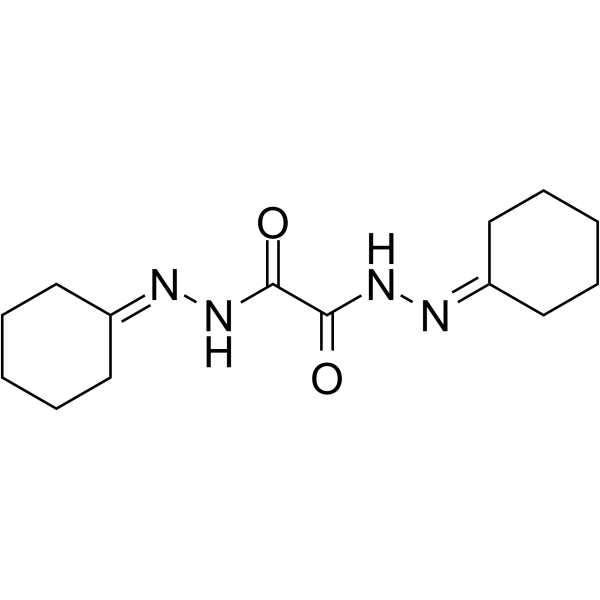oxalic bis(cyclohexylidenehydrazide)

oxalic bis(cyclohexylidenehydrazide) structure
|
Common Name | oxalic bis(cyclohexylidenehydrazide) | ||
|---|---|---|---|---|
| CAS Number | 370-81-0 | Molecular Weight | 278.350 | |
| Density | 1.3±0.1 g/cm3 | Boiling Point | N/A | |
| Molecular Formula | C14H22N4O2 | Melting Point | 210-214 °C(lit.) | |
| MSDS | Chinese USA | Flash Point | N/A | |
|
Effect of high-dose 1.25 dihydroxyvitamin D3 on remyelination in the cuprizone model.
APMIS 122(12) , 1178-86, (2014) Vitamin D supplementation is increasingly recommended to patients with multiple sclerosis (MS). To study the effect of high-dose vitamin D on remyelination, female C57Bl/6 mice were demyelinated with dietary 0.2% cuprizone for 7 weeks. The mice received intra... |
|
|
Behavioural changes observed in demyelination model shares similarities with white matter abnormalities in humans.
Behav. Brain Res. 287 , 265-75, (2015) Multiple sclerosis (MS) is a chronic, inflammatory, demyelinating disease of the central nervous system (CNS). Further to the symptoms resulting from demyelination, new studies point to the involvement of neuroinflammation and white matter abnormalities in ps... |
|
|
Prion protein and copper cooperatively protect neurons by modulating NMDA receptor through S-nitrosylation.
Antioxid. Redox Signal. 22(9) , 772-84, (2015) Several neurodegenerative disorders show alterations in glutamatergic synapses and increased susceptibility to excitotoxicity. Mounting evidence suggests a central role for the cellular prion protein (PrP(C)) in neuroprotection. Therefore, the loss of PrP(C) ... |
|
|
Characterization of Periodic Acid-Schiff-Positive Granular Deposits in the Hippocampus of SJL/J Mice.
Toxicol. Pathol. 43 , 737-42, (2015) Periodic acid-Schiff (PAS)-positive granular deposits in the hippocampus have been reported previously in certain inbred mouse strains such as C57BL/6 and the senescent-accelerated mouse prone-8. Here, we report for the first time that similar PAS-positive gr... |
|
|
Specific ablation of Nampt in adult neural stem cells recapitulates their functional defects during aging.
EMBO J. 33(12) , 1321-40, (2014) Neural stem/progenitor cell (NSPC) proliferation and self-renewal, as well as insult-induced differentiation, decrease markedly with age. The molecular mechanisms responsible for these declines remain unclear. Here, we show that levels of NAD(+) and nicotinam... |
|
|
Adult neural precursor cells from the subventricular zone contribute significantly to oligodendrocyte regeneration and remyelination.
J. Neurosci. 34(42) , 14128-46, (2014) Parenchymal oligodendrocyte progenitor cells (pOPCs) are considered the principal cell type responsible for oligodendrogenesis and remyelinaton in demyelinating diseases. Recent studies have demonstrated that neural precursor cells (NPCs) from the adult subve... |
|
|
A regenerative approach to the treatment of multiple sclerosis.
Nature 502(7471) , 327-32, (2013) Progressive phases of multiple sclerosis are associated with inhibited differentiation of the progenitor cell population that generates the mature oligodendrocytes required for remyelination and disease remission. To identify selective inducers of oligodendro... |
|
|
TREM2 regulates microglial cell activation in response to demyelination in vivo.
Acta Neuropathol. 129(3) , 429-47, (2015) Microglia are phagocytic cells that survey the brain and perform neuroprotective functions in response to tissue damage, but their activating receptors are largely unknown. Triggering receptor expressed on myeloid cells 2 (TREM2) is a microglial immunorecepto... |
|
|
Reduced astrocytic NF-κB activation by laquinimod protects from cuprizone-induced demyelination.
Acta Neuropathol. 124(3) , 411-24, (2012) Laquinimod (LAQ) is a new oral immunomodulatory compound that reduces relapse rate, brain atrophy and disability progression in multiple sclerosis (MS). LAQ has well-documented effects on inflammation in the periphery, but little is known about its direct act... |
|
|
Inflammatory response and chemokine expression in the white matter corpus callosum and gray matter cortex region during cuprizone-induced demyelination.
J. Mol. Neurosci. 48(1) , 66-76, (2012) Brain inflammation plays a central role in multiple sclerosis (MS). Besides lymphocytes, the astroglia and microglia mainly contribute to the cellular composition of the inflammatory infiltrate in MS lesions. Several studies were able to demonstrate that cort... |